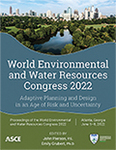Stormwater Forecasting—A New Indicator to Manage Basin-Scale Urban Runoff Volume
Publication: World Environmental and Water Resources Congress 2022
ABSTRACT
Since 2001, the Metropolitan North Georgia Water Planning District (District) has coordinated strategies to protect watershed conditions and manage stormwater in conjunction with existing regulatory requirements. However, despite these efforts, urban stormwater runoff remains a leading cause of nonpoint source pollution and flooding in the District, leaving watershed managers with ongoing challenges related to water quality, streambank erosion, and nuisance flooding. Historically, managers have primarily focused on strategies to address water quality rather than water quantity, even though they are fundamentally linked. For these reasons, the District has developed a novel water quantity-based indicator, called the Stormwater Forecast (Forecast), as part of the integrated 2022 Water Resources Management Plan. The Forecast is a planning-level estimate of the total potential runoff management volume from development, calculated at the basin scale using site-scale post-construction stormwater performance standards. With this approach, the Forecast represents a full accounting of the runoff volume from developed lands that have the potential to be managed by stormwater control measures (SCMs), for example, traditional stormwater ponds or bioretention basins, if current post-construction stormwater management standards were fully in place. Future use of the Forecast is intended to complement and support the implementation of existing water quality and flood reduction goals in the District.
Get full access to this article
View all available purchase options and get full access to this chapter.
REFERENCES
ASCE. 2021. Stormwater. Infrastructure Report Card. https://infrastructurereportcard.org/. Accessed December 7, 2021.
ARC (Atlanta Regional Commission). 2016. Georgia Stormwater Management Manual.
ARC. 2021. Population and Employment Projections - 2020 to 2050. https://atlantaregional.org/atlanta-region/population-employment-forecasts/. Accessed September 9, 2021.
CDM Smith. 2021. Determining Future Rainfall Frequency Estimates for MNGWPD Service Area.
GAEPD (Georgia Environmental Protection Division). 2020. Water Quality in Georgia 2018-2019 (2020 Integrated 305b/303d Report).
Hallauer, A. M., Behrend, G., Bell, D., Tyagi, A., and Cohen, B. 2019. Financing Resilience in Atlanta using an Environmental Impact Bond.
OPB (Governor’s Office of Planning and Budget). 2021. Population Projections and OPB-Based Employment Projections - 2020 to 2050. https://opb.georgia.gov/census-data/population-projections. Accessed September 9, 2021.
MNGWPD (Metropolitan North Georgia Water Planning District). 2017. Water Resources Management Plan.
MNGWPD. 2021. About The Metro Water District. https://northgeorgiawater.org/what-is-the-metro-water-district/. Accessed November 2, 2021.
NOAA (National Oceanic and Atmospheric Administration). 2013. NOAA Atlas 14 – Precipitation-Frequency Atlas of the United States.
NRC (National Research Council). 2008. Urban Stormwater Management in the United States. The National Academies Press. Washington, DC.
NRCS (National Resources Conservation Service). 1986. Technical Release 55 – Urban Hydrology for Small Watersheds.
NRCS. 2010. National Engineering Handbook. Part 630. Chapter 15 – Time of Concentration.
NRCS. 2021. Web Soil Survey. https://websoilsurvey.sc.egov.usda.gov/App/WebSoilSurvey.aspx. Accessed September 15, 2021.
Terando, A. J., Costanza, J., Belyea, C., Dunn, R. R., McKerrow, A., and Collazo, J. A. 2014. The Southern Megalopolis: Using the Past to Predict the Future of Urban Sprawl in the Southeast U.S. PLoS ONE 9(7): e102261. https://doi.org/10.1371/journal.pone.0102261.
USCB (United States Census Bureau). 2008. Georgia Census County Boundaries. https://data.georgiaspatial.org/. Accessed September 15, 2021.
USEPA (United States Environmental Protection Agency). 2012. National Hydrography Dataset Plus. https://www.epa.gov/waterdata/nhdplus-national-hydrography-dataset-plus. Accessed June 2, 2021.
USEPA. 2020. Environmental Financial Advisory Board.
USGS (United States Geological Survey). 2007. Multi-Resolution Land Characteristics Consortium (MRLC) – 2001 National Land Cover Database (NLCD). https://www.mrlc.gov/. Accessed September 15, 2021.
USGS. 2011. Methods for Estimating the Magnitude and Frequency of Floods in Urban and Small, Rural Streams in Georgia, South Carolina, and North Carolina. https://doi.org/10.3133/sir20145030.
USGS. 2017. National Map 3DEP Downloadable Data Collection – 1/3rd Arc-Second Digital Elevation Model. https://data.usgs.gov/datacatalog/data/USGS:3a81321b-c153-416f-98b7-cc8e5f0e17c3. Accessed September 15, 2021.
USGS. 2021. Multi-Resolution Land Characteristics Consortium (MRLC) – 2019 National Land Cover Database (NLCD). https://www.mrlc.gov/. Accessed June 2, 2021.
WEF (Water Environment Federation). 2020. National Municipal Separate Stormwater Sewer System (MS4) Needs Assessment Survey Results. WEF Stormwater Institute.
Wycoff, R. L., and Singh, U. P. 1976. Preliminary Hydrologic Design of Small Flood Detention Reservoirs. Water Resources Bulletin. Vol. 12, No. 2, pp 337–47.
Information & Authors
Information
Published In
History
Published online: Jun 2, 2022
Authors
Metrics & Citations
Metrics
Citations
Download citation
If you have the appropriate software installed, you can download article citation data to the citation manager of your choice. Simply select your manager software from the list below and click Download.
